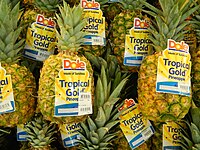
Zinc oxide (ZnO) nanoparticles elevated iron and copper contents and mitigated the bioavailability of lead and cadmium in different leafy greens.
Sign Up to like & getrecommendations! Published in 2020 at "Ecotoxicology and environmental safety"
DOI: 10.1016/j.ecoenv.2020.110177
Abstract: Advances in large hydroponic production of leafy greens, easy adoption in urban agriculture, and large leaf surface area of many leafy greens, greatly increase their exposure to heavy metals and nanoparticles. Cadmium (Cd) and lead… read more here.
Keywords: copper; zinc oxide; heavy metals; edible tissues ... See more keywords

Minimizing pathogen growth and quality deterioration of packaged leafy greens by maintaining optimum temperature in refrigerated display cases with doors
Sign Up to like & getrecommendations! Published in 2018 at "Food Control"
DOI: 10.1016/j.foodcont.2018.05.024
Abstract: Abstract Retail display of packaged fresh-cut leafy greens is a critical stage of cold chain management and is prone to temperature fluctuations when produce is displayed in open cases, due to infiltration of ambient air… read more here.
Keywords: temperature; cases doors; display; display cases ... See more keywords

Interaction of microorganisms within leafy green phyllospheres: Where do human noroviruses fit in?
Sign Up to like & getrecommendations! Published in 2017 at "International journal of food microbiology"
DOI: 10.1016/j.ijfoodmicro.2017.07.010
Abstract: Human noroviruses (hNoV) are one of the major causes of foodborne disease outbreaks linked to leafy greens. However, the interactions-including attachment and persistence-of hNoV with leafy greens are not well characterized. In the present review,… read more here.
Keywords: leafy green; green phyllospheres; hnov; leafy greens ... See more keywords

Stomatal response and human pathogen persistence in leafy greens under preharvest and postharvest environmental conditions
Sign Up to like & getrecommendations! Published in 2019 at "Postharvest Biology and Technology"
DOI: 10.1016/j.postharvbio.2018.10.013
Abstract: Abstract Human pathogens can internalize and persist inside crop plants leading to foodborne outbreaks and illnesses. Pathogenic bacteria might use natural openings on the plant surface, such as the stomatal pore, to penetrate the leaf… read more here.
Keywords: environmental conditions; leafy greens; stomatal response; plant ... See more keywords

Affordability of nutritious foods for complementary feeding in South Asia
Sign Up to like & getrecommendations! Published in 2021 at "Nutrition Reviews"
DOI: 10.1093/nutrit/nuaa139
Abstract: Abstract The high prevalence of stunting and micronutrient deficiencies among children in South Asia has lifelong health, educational, and economic consequences. For children aged 6–23 months, undernutrition is influenced by inadequate intake of complementary foods containing… read more here.
Keywords: affordable sources; affordability nutritious; south asia; dark leafy ... See more keywords

Internalization of Salmonella in Leafy Greens and Impact on Acid Tolerance
Sign Up to like & getrecommendations! Published in 2022 at "Applied and Environmental Microbiology"
DOI: 10.1128/aem.02249-21
Abstract: Consumption of leafy greens has been increasingly associated with foodborne illnesses, and their contamination could occur at the pre- and/or postharvest level. Human pathogens may become passively or actively internalized in plant tissues, thereby escaping… read more here.
Keywords: leafy greens; salmonella; leafy; salmonella leafy ... See more keywords

Field study of parasitic contamination of fruits, vegetables and leafy greens in the Ecuadorian Andes
Sign Up to like & getrecommendations! Published in 2023 at "F1000Research"
DOI: 10.12688/f1000research.132957.1
Abstract: Background: Raw vegetables have been considered vehicles of enteroparasites. South American countries are among the most important exporters of fresh vegetables; Ecuador has tropical climates and soils rich in organic matter that allow it to… read more here.
Keywords: leafy greens; parasitic contamination; spp; fruits vegetables ... See more keywords

Foliar Roughness and Water Content Impact on Escherichia coli Attachment in Baby Leafy Greens
Sign Up to like & getrecommendations! Published in 2023 at "Biology"
DOI: 10.3390/biology12010102
Abstract: Simple Summary Vegetables may host human pathogens, such as Salmonella enterica and Escherichia coli. Therefore, the consumption of salads may raise safety concerns as they are eaten raw and often without prior proper washing. Bringing… read more here.
Keywords: leafy greens; water content; roughness water; susceptibility ... See more keywords

Outbreaks of Shiga Toxin-Producing Escherichia coli Linked to Sprouted Seeds, Salad, and Leafy Greens: A Systematic Review.
Sign Up to like & getrecommendations! Published in 2019 at "Journal of food protection"
DOI: 10.4315/0362-028x.jfp-19-014
Abstract: Shiga toxin-producing Escherichia coli (STEC) outbreaks involving ready-to-eat salad products have been described in the scientific literature since 1995. These products typically do not undergo a definitive control step such as cooking to eliminate pathogens.… read more here.
Keywords: review; leafy greens; toxin producing; escherichia coli ... See more keywords